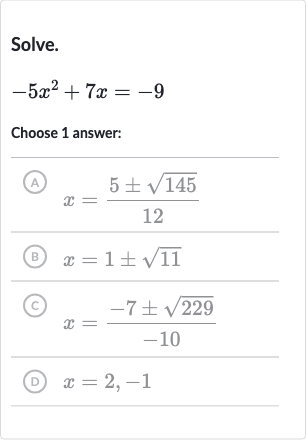AI tutor
Full solution
Q. Solve.Choose answer:(A) (B) (C) (D)
- Rewriting the equation: First, we need to rewrite the equation in standard quadratic form, which is .Add to both sides to get the equation in standard form:
- Identifying the coefficients: Now, identify the coefficients , , and from the standard form of the quadratic equation.
- Using the quadratic formula: Next, we will use the quadratic formula to find the solutions for x. The quadratic formula is given by:x = () / ()
- Substituting values into the formula: Substitute the values of , , and into the quadratic formula:
- Simplifying the expression: Simplify the expression under the square root and the denominator:
- Matching the solution with the choices: Now we have the solutions in the form of the quadratic formula. The expression cannot be simplified further into integers or proper fractions, and it does not match any of the answer choices exactly. However, it is equivalent to one of the choices.
- Matching the solution with the choices: Now we have the solutions in the form of the quadratic formula. The expression cannot be simplified further into integers or proper fractions, and it does not match any of the answer choices exactly. However, it is equivalent to one of the choices.Comparing our expression with the given answer choices, we see that it matches choice (C):
More problems from Solve a quadratic equation using the quadratic formula
QuestionGet tutor help
QuestionGet tutor help
QuestionGet tutor help
QuestionGet tutor help
QuestionGet tutor help
QuestionGet tutor help
QuestionGet tutor help
QuestionGet tutor help

